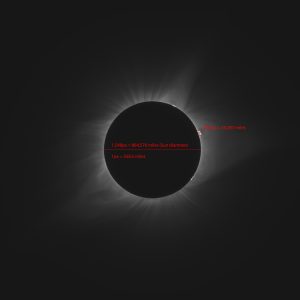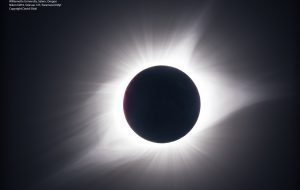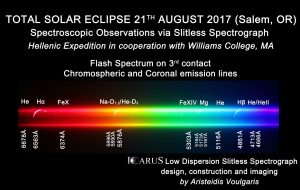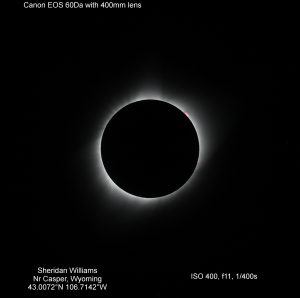
Sone NSF-linked observations of the 2017 eclipse
Lunar Limb Profiles at Total Solar Eclipses
Williams College Press Release on the the “Successful” Great American Eclipse
Russian Translation: https://mygpstools.com/11-avgusta-2018-goda-v-arktike-skandinaviya-rossiya-chastichno
Eclipse pairs 2017-2024 ± saros intervals
The Williams College Eclipse Expedition was in Salem, Oregon, for the total solar eclipse that occurred on August 21, 2017. The following are a selection of composites and raw images from the eclipse team.
Images and Composites by David Sliski:
Flash coronal spectra by Aris Voulgaris as part of the Williams College Expedition
Note spectral lines from Fe X, Fe XIV, Ar X, Ni XIII
Spectra Taken at the Great American Eclipse by Aris Voulgaris:
Spaceweather.com (from NASA’s Solar Dynamics Observatory’s Helioseismic and Magnetic Imager) White-Light Images Taken on August 21st and 22nd of 2017:
Rob Lucas Images:
Photo by Alex Fedotowsky at Weiser, Idaho:
Image taken with a Canon SX530 with a built-in 50x telephoto
More Eclipse Images
Wide-Field Image Taken at Salem, Oregon, with an iPhone by Deborah Popper
More Eclipse Images taken by Other Expedition Participants
Students and Alumni present at The Great American Eclipse in Salem, Oregon:

From left to right – Back: Cielo Perez ’19, Charles Ide ’20, Marcus Freeman ’10, Duane Lee ’01, Muzhou Lu ’13, Allen Davis ’14, Dan Seaton ’01, Declan Daly ’20, Brendan Rosseau ‘ 19
From left to right – Front: Erin Meadors ’20, Ross Yu ’19, Amy Steele ’08, Connor Marti ’20, Christian Lockwood ’20
(Not shown, at our alternative site in Salem, Tim Nagle-mcNaughton ‘ 18 and Suranjit Tilakawardane ’07)
Zoltan Levay, Space Telescope Science Institute Picture Gallery
Review of ArtCenter Show in Pasadena, California
Various Websites to Prepare You For the Eclipse!
The Total Solar Eclipse Explained
Mapping the Great American Eclipse
How to Get Kids Excited About the Great American Eclipse
The First Solar Eclipse in 99 Years is Coming. To Some, It’s an Act of God
Total Solar Eclipses in the USA
Will the 2017 Eclipse Prove the Sun is Bigger Than We Think?
Historical eclipse coins; Astronomy Magazine article
Pasachoff, Penn, Des Jardins, Baer:
Espenak, Liebenberg, Schneider, Pasachoff
Zeiler:
Total Eclipse of the Sun Video (BBC)
The Sky Event of the Decade—Video Available
Interview with JMP:
Solar eclipse from Madras, Oregon, from Bill Bentley Productions
Aerial photo of the eclipse by Jon Carmichael
- https://mymodernmet.com/jon-carmichael-total-eclipse-photo/
- https://joncarmichael.com
- https://petapixel.com/2018/08/27/this-eclipse-photo-was-shot-from-a-commercial-plane-at-39000ft/
For the tours led by Prof. Pasachoff
13 August 2018:
A RECORD NUMBER OF AMERICANS WATCHED THE
2017 SOLAR ECLIPSE — AND SOUGHT SCIENCE AFTERWARD
The 2017 total solar eclipse spurred a flurry of interest about solar eclipses, according to the final report of a survey led by the University of Michigan.
A follow-up survey of American adults who viewed the August 2017 total solar eclipse showed that the eclipse drove people to gather information about 16 times in the three months following the event. This level of adult information-seeking after an event is higher than previously reported for any similar scientific event. The eclipse fostered a good deal of conversation, with the average adult reporting eight conversations with other people about the eclipse or related scientific issues.
“What we found was that there was a substantial amount of people going online, going to libraries, talking to their friends, trying to figure out what was going to happen with the eclipse before and after the event,” said Jon Miller, director of the International Center for the Advancement of Scientific Literacy at U-M’s Institute for Social Research. “To a large extent, scholars have watched what people do before a scientific event, but not what they do after. The event can be a stimulus that causes people to look for more information.”
In partnership with NASA, Miller leads a national study that examines Americans’ scientific literacy and how they seek scientific information. In a typical year, his research team administers two waves of surveys: one at the beginning of the year and one at the end. Because of the total solar eclipse — the first in North America in nearly a century — Miller added another survey just weeks after the August 2017 event in order to capture people’s experiences as they were fresh.
Miller’s final report confirms that 88 percent of American adults viewed the total solar eclipse directly or electronically. This audience of 216 million adults ages 18 and older is one of the largest recorded for any scientific, athletic or entertainment event.
During the two months prior to the August 21 eclipse, the 154 million American adults who viewed the eclipse reported that they engaged in an average of 15 information-seeking activities related to the eclipse. A follow-up survey at the end of the year found that adults sought information about the eclipse and related solar and space issues after the eclipse at essentially the same rate reported prior to the eclipse.
Twenty-one million adults who traveled to a different location to view the eclipse reported an average of 24 information-seeking activities during the two months prior to the eclipse. These viewers were usually seeking a higher degree of totality. An additional 62 million American adults viewed the eclipse electronically on television, a computer screen, a tablet or their smartphone.
Talking with friends and family and sharing information about the forthcoming eclipse was the most common information-seeking activity, followed by reading a story either in print or online in a newspaper or magazine.
American adults who viewed the eclipse reported an average of two online searches for eclipse-related information during the two months prior to the event. Those who viewed the eclipse used a combination of solar glasses designed to allow the direct viewing of the Sun and various other devices — pinhole projectors, for example.
“This level of public interest and information seeking about a science-oriented event is unparalleled,” Miller said. “It suggests that groups and organizations interested in fostering increased adult interest in science should think about post-event programming to provide resources and a forum for these discussions.”
Miller’s survey — beginning on the evening of the eclipse and continuing for a week after the event — found that most adults viewed the eclipse with other their family, friends or co-workers. Only 3 percent viewed the eclipse as a part of an organized group. Miller noted that this was not unexpected since the eclipse occurred midday on a normal work day.
The 2017 Michigan Scientific Literacy Study is based on a national probability sample of U.S. households from a U.S. Postal Service listing of all occupied households. The data were collected by AmeriSpeak, a panel service operated by the National Opinion Research Center at the University of Chicago.
The February-March survey included online and telephone interviews with 2,834 adults ages 18 and older, and 2,175 of the same adults responded to a follow-up survey in August immediately after the eclipse. A third survey was conducted with the same individuals at the end of 2017, beginning in October, and the third wave was completed by 2,212 respondents. This three-wave design allows the tracking of the same individuals prior to the eclipse, immediately after the eclipse and three months after the eclipse.
Reference:
“Americans and the 2017 Eclipse: A Final Report on Public Viewing of the August Total Solar Eclipse,” Jon D. Miller (University of Michigan), 2018 June 12 [PDF: https://isr.umich.edu/wp-content/uploads/sites/84/2018/08/Final-Eclipse-Viewing-Report.pdf].
September 2017 press release on preliminary survey results:
“A Record Number of Americans Viewed the 2017 Solar Eclipse”
https://news.umich.edu/a-record-number-of-americans-viewed-the-2017-solar-eclipse/
Elizabeth Landau’s article in Smithsonian Magazine on the Light-Deflection Einstein/Eddington Experiment
Jay Pasachoff’s review of Dan Kennefick’s book
No Shadow of a Doubt: The 1919 Eclipse that Confirmed Einstein’s Theory of Relativity (Princeton University Press, 2019)
http://www.keyreporter.org/BookReviews/LifeOfTheMind/Details/2714.html
Pasachoff, Jay M., Christian A. Lockwood, Erin Meadors, Ross Yu, Cielo Perez, Marcos A. Peñaloza-Murillo, Daniel B. Seaton, Aris Voulgaris, Ron Dantowitz, Vojtech Rušin, Thanasis Economou, 2018, “Images and Spectra of the 2017 Total Solar Eclipse Corona from our Oregon Site,” in Scott W. McIntosh, Michael Thompson, Chris G. Tzanis, eds., Frontiers in Astronomy and Space Sciences: The Great American Eclipse of August 21, 2017 – Connecting Solar and Terrestrial Science, Frontiers in Astronomy and Space Sciences. 5:37. doi: 10.3389/fspas.2018.00037. https://www.frontiersin.org/articles/10.3389/fspas.2018.00037/full
Peñaloza-Murillo, Marcos A., and Jay M. Pasachoff, 2018, “The longest total occultation of the Sun of the 21st century at Tianhuangping (Zhejiang), China: Air-temperature observations and its theoretical analysis under adverse meteorological conditions,” J. Geophys. Res.: Atmospheres, 123, DOI: 10.1029/2018JD029253
https://agupubs.onlinelibrary.wiley.com/doi/pdf/10.1029/2018JD029253
Pasachoff, Jay M., and Andrew Fraknoi, 2017, “Resource Letter OSE-1 on Observing Solar Eclipses,” American Journal of Physics 85(7), 485-494, July.
https://aapt.scitation.org/doi/pdf/10.1119/1.4985062
114. Pasachoff, Jay M., 2017, “The Great Solar Eclipse of 2017,” Scientific American, 317, #2, 54-61, August.
115. Pasachoff, Jay M., 2017, “Heliophysics at Total Solar Eclipses,” Nature Astronomy 1, article number 0190 (August). https://www.nature.com/articles/s41550-017-0190 http://rdcu.be/uEuz
116. Mikic, Zoran, Cooper Downs, Jon A. Linker, Ronald M. Caplan, Duncan Mackay, Lisa Upton, Pete Riley, Roberto Lionello, Tibor Török, Viacheslav Titov, Janvier Wijaya, Miloslav Druckmüller, Jay M. Pasachoff, and Wendy Carlos, 2018, “Predicting the Corona for the 21 August 2017 Total Solar Eclipse,” Nature Astronomy 2, pp. 913–921, https://doi.org/10.1038/s41550-018-0562-5;
https://rdcu.be/5iVS
117. Pasachoff, Jay M., 2018, “Science at the Great American Eclipse,” Astronomy & Geophysics (A&G), 59 (August), 4.1-4.5.
118. Pasachoff, Jay M., 2018, “Education and Outreach about Science at the 2017 Eclipse,” in The 2017 Total Solar Eclipse, Astronomical Society of the Pacific Conference Series, Sanlyn Buxner, Linda Shore, and Joe Jensen, eds., pp. 331-336.






































